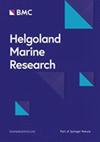波罗的海外缘硅藻在气候、空间和物理化学变量上的分布格局
4区 地球科学
Q2 Agricultural and Biological Sciences
引用次数: 7
摘要
为提高对北欧波罗的海半咸水生态系统中硅藻生物多样性的认识,对其物种丰富度和群落组成进行了研究。人们对波罗的海的许多生物进行了广泛的研究,但对沿海硅藻的研究却很少。本研究的目的是研究气候、空间和水的物理化学变量在芬兰湾和波黑湾的驱动因素中的重要性。pH、全磷和全氮最能解释物种丰富度的变化。冗余分析表明,气温、硅、总磷、水温、盐度和ph是影响物种组成的最重要因子。变异分区表明,物种组成主要受气候和空间变量的影响,而物理化学变量的影响较小。然而,气候、空间和物理化学因素的综合影响是最强的。结果表明,波罗的海北部硅藻物种丰富度主要受局地因子调控,气候和空间变量对丰富度影响不大。物种组成主要受气候和空间变量的影响。我们得出结论,了解波罗的海硅藻的分布模式需要包括气候、空间和水化学变量。本文章由计算机程序翻译,如有差异,请以英文原文为准。
Distribution patterns of epilithic diatoms along climatic, spatial and physicochemical variables in the Baltic Sea
The species richness and community composition of the diatom communities were studied in the Baltic Sea, Northern Europe, to enhance knowledge about the diversity of these organisms in a brackish water ecosystem. Many organisms in the Baltic Sea have been studied extensively, but studies investigating littoral diatoms are scarce. The goal of this study was to examine the importance of climatic, spatial and water physicochemical variables as drivers of epilithic diatoms in the Gulf of Finland and the Gulf of Bothnia. The variation in species richness was best explained by pH, total phosphorus and total nitrogen. Redundancy Analysis indicated that the most important factors correlating with species composition were air temperature, silicon, total phosphorus, water temperature, salinity and pH. Variation Partitioning showed that the species composition was mostly affected by climatic and spatial variables, whereas physicochemical variables had little impact. However, the strongest factor was the combined influence of climatic, spatial and physicochemical variables. The results suggest that diatom species richness in the northern Baltic Sea is primarily regulated by local factors, while climatic and spatial variables have little impact on richness. Species composition is mostly affected by climatic and spatial variables. We conclude that understanding the distribution patterns of Baltic Sea diatoms requires the inclusion of climatic, spatial and water chemistry variables.
求助全文
通过发布文献求助,成功后即可免费获取论文全文。
去求助
来源期刊

Helgoland Marine Research
地学-海洋学
自引率
0.00%
发文量
0
审稿时长
6-12 weeks
期刊介绍:
Helgoland Marine Research is an open access, peer reviewed journal, publishing original research as well as reviews on all aspects of marine and brackish water ecosystems, with a focus on how organisms survive in, and interact with, their environment.
The aim of Helgoland Marine Research is to publish work with a regional focus, but with clear global implications, or vice versa; research with global emphasis and regional ramifications. We are particularly interested in contributions that further our general understanding of how marine ecosystems work, and that concentrate on species’ interactions.
 求助内容:
求助内容: 应助结果提醒方式:
应助结果提醒方式:


